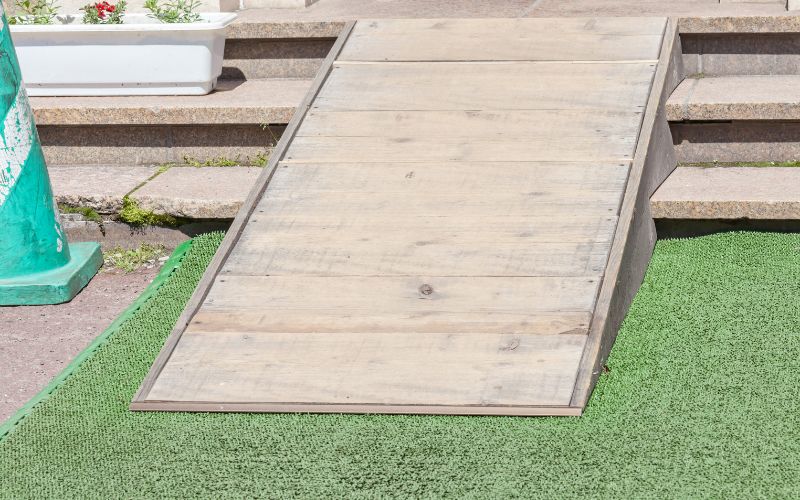Inclined planes are simple machines that have been integral to human civilization for centuries. They make tasks easier by reducing the amount of force needed to move objects. From everyday objects to massive structures, inclined planes are everywhere. Let’s explore 20 examples of inclined planes that showcase their versatility and importance in our lives.
Examples of Inclined Planes
Examples of inclined planes are given below;
1. Ramps
Ramps are sloped surfaces that connect two different levels, allowing for easier movement of objects or individuals. They are commonly used in buildings, vehicles, and outdoor spaces to facilitate accessibility. Ramps are crucial for wheelchair users, people pushing strollers, and for loading and unloading heavy objects.
2. Slides
Slides are playground equipment consisting of a smooth, sloping surface that allows children to slide down for enjoyment. They are often found in parks, schools, and recreational areas, providing a fun and exciting activity for children.
3. Roads

Roads incorporate inclined planes in the form of hills or slopes to navigate changes in elevation. Inclined roads are designed to facilitate vehicular movement, providing a smoother transition between different levels of terrain.
4. Hiking Trails
Hiking trails frequently include inclined planes, especially in mountainous regions where trails traverse steep slopes. These inclined paths allow hikers to ascend or descend safely while enjoying scenic views and exploring natural landscapes.
5. Ski Slopes
Ski slopes are carefully groomed inclined planes used for skiing and snowboarding. These slopes vary in steepness and difficulty levels, catering to beginners and experienced skiers alike. Ski slopes often incorporate lifts or tow ropes to transport skiers to the top for another run.
6. Roller Coasters
Roller coasters utilize inclined planes to generate thrilling rides based on gravity-driven motion. Inclined tracks enable roller coaster cars to ascend steep slopes before plummeting down thrilling drops and twists, providing an exhilarating experience for riders.
7. Staircases
Staircases consist of a series of steps arranged in an inclined plane, allowing individuals to ascend or descend between different levels of a building or structure. Staircases are essential for vertical movement in buildings and are designed to accommodate various architectural styles and functional requirements.
8. Escalators
Escalators are moving staircases commonly found in public spaces such as malls, airports, and train stations. They consist of a continuous loop of steps that move along inclined planes, transporting passengers smoothly between different levels of a building.
9. Wheelchair Ramps

Wheelchair ramps are inclined surfaces designed to provide accessibility for individuals using wheelchairs or other mobility aids. These ramps are essential in buildings, public spaces, and transportation hubs, ensuring inclusivity and ease of movement for people with disabilities.
10. Dock Ramps
Dock ramps are inclined surfaces used for loading and unloading cargo from ships or trucks onto docks. These ramps facilitate the movement of goods between different modes of transportation and storage facilities, such as warehouses and distribution centers.
11. Car Ramps
Car ramps are inclined surfaces used in garages, car parks, and automotive repair facilities for vehicle maintenance and storage. These ramps allow vehicles to be raised to a desired height for inspection, repairs, or storage purposes.
12. Water Slides
Water slides are amusement park attractions that incorporate inclined planes and water flow to provide exhilarating rides. Riders slide down the inclined surface propelled by water, experiencing twists, turns, and drops along the way, creating a thrilling recreational experience.
13. Rooftop Ramps
Rooftop ramps are inclined surfaces installed on rooftops to provide access for maintenance personnel, firefighters, or for recreational purposes. These ramps allow safe and convenient access to rooftop areas for various activities such as maintenance, inspections, or leisure.
14. Sled Runs
Sled runs are inclined surfaces covered with snow or ice used for sledding or tobogganing. These runs provide a thrilling recreational activity during winter months, allowing individuals to slide down slopes on sleds or toboggans for enjoyment.
15. Bicycle Ramps
Bicycle ramps are inclined paths designed for cyclists to navigate changes in elevation, such as ramps in bike parks or cycling trails. These ramps enable cyclists to ascend or descend slopes safely while riding bicycles, enhancing the biking experience.
16. Skateboard Ramps
Skateboard ramps are inclined surfaces used by skateboarders to perform tricks and maneuvers. These ramps, also known as skate ramps or halfpipes, allow skateboarders to gain speed and momentum while executing various stunts and aerial maneuvers.
17. Avalanche Barriers
Avalanche barriers are structures installed on mountainsides to mitigate the risk of avalanches. These barriers, often made of reinforced concrete or steel, are strategically placed along inclined slopes to divert or contain snow and debris during avalanche events, protecting infrastructure and human lives.
18. Ski Jump Ramps
Ski jump ramps are specially designed inclined planes used in ski jumping competitions. These ramps feature a steep slope and a take-off table, allowing skiers to gain speed and momentum before launching into the air to perform jumps and aerial maneuvers, showcasing their skiing skills and athleticism.
19. Aircraft Carrier Ramps
Aircraft carrier ramps, also known as flight decks or ski jumps, are angled decks located at the bow of aircraft carriers. These ramps are used for launching fixed-wing aircraft, providing additional lift and acceleration during takeoff operations, particularly for aircraft with short takeoff and vertical landing capabilities.
20. Pyramids
Pyramids are ancient structures characterized by their monumental triangular shape, consisting of inclined planes as part of their architecture. In ancient civilizations such as Egypt, pyramids were constructed using inclined planes to transport and position massive stone blocks, showcasing advanced engineering and architectural techniques of the time.
FAQs about Inclined Planes:
Q1: What is an inclined plane?
An inclined plane is a simple machine consisting of a flat surface that is tilted at an angle. It allows objects to be moved from a lower to a higher point or vice versa with less force.
Q2: How do inclined planes make work easier?
Inclined planes reduce the amount of force needed to move objects vertically by spreading the work over a longer distance along the slope.
Q3: What are some real-life examples of inclined planes?
Real-life examples of inclined planes include ramps, staircases, roads, ski slopes, and wheelchair ramps.
Q4: Can inclined planes be found in nature?
Yes, natural examples of inclined planes include mountain slopes, riverbanks, and dunes, where the incline assists in movement or erosion.

